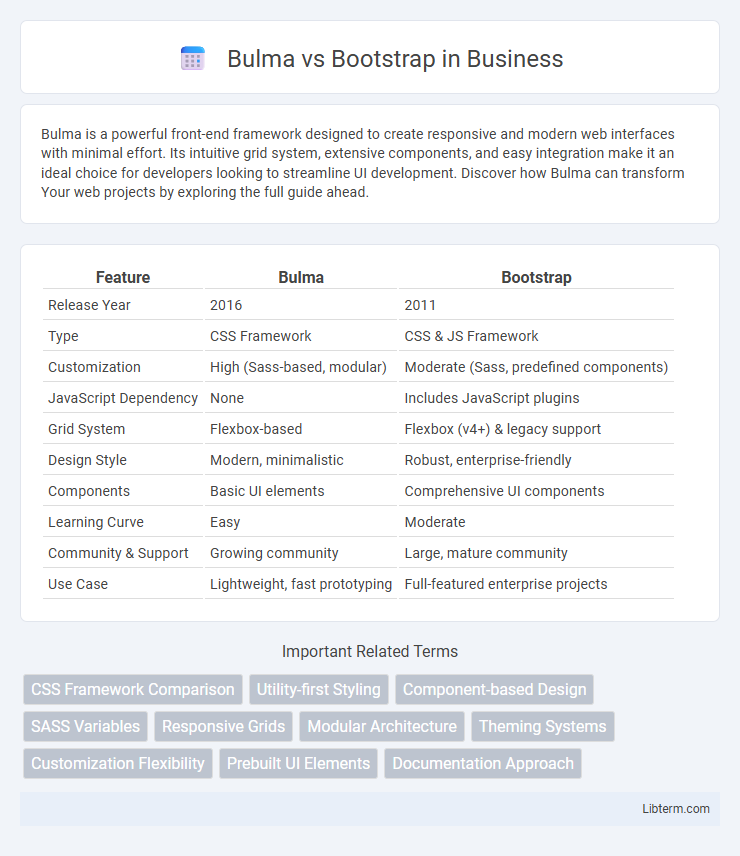Bulma is a powerful front-end framework designed to create responsive and modern web interfaces with minimal effort. Its intuitive grid system, extensive components, and easy integration make it an ideal choice for developers looking to streamline UI development. Discover how Bulma can transform Your web projects by exploring the full guide ahead.
Table of Comparison
| Feature | Bulma | Bootstrap |
|---|---|---|
| Release Year | 2016 | 2011 |
| Type | CSS Framework | CSS & JS Framework |
| Customization | High (Sass-based, modular) | Moderate (Sass, predefined components) |
| JavaScript Dependency | None | Includes JavaScript plugins |
| Grid System | Flexbox-based | Flexbox (v4+) & legacy support |
| Design Style | Modern, minimalistic | Robust, enterprise-friendly |
| Components | Basic UI elements | Comprehensive UI components |
| Learning Curve | Easy | Moderate |
| Community & Support | Growing community | Large, mature community |
| Use Case | Lightweight, fast prototyping | Full-featured enterprise projects |
Introduction to Bulma and Bootstrap
Bulma is a modern CSS framework based on Flexbox, offering a clean, responsive, and modular approach to web design with no JavaScript dependencies, making it lightweight and easy to customize. Bootstrap, developed by Twitter, is a comprehensive front-end toolkit combining CSS, JavaScript, and custom components designed for building responsive, mobile-first websites with extensive prebuilt elements and a robust grid system. Both frameworks facilitate rapid UI development but differ in structure, with Bulma emphasizing simplicity and flexibility, while Bootstrap provides extensive interactive components and broader browser support.
Core Philosophy and Design Principles
Bulma emphasizes a modern, flexbox-based CSS framework designed for simplicity and modularity, prioritizing clean, semantic classes that encourage readable and maintainable code. Bootstrap follows a comprehensive, component-rich approach with utility classes and JavaScript plugins, aiming for rapid prototyping and extensive cross-browser compatibility. Bulma's core philosophy centers on being lightweight and stylesheet-focused, while Bootstrap focuses on providing a full-featured toolkit with integrated JavaScript functionalities.
Installation and Setup Process
Bulma requires a straightforward installation using npm or Yarn with commands like `npm install bulma` followed by importing the CSS file into your project, making it quick to set up for modern web development workflows. Bootstrap offers multiple installation options, including CDN links for immediate use, npm packages for integration into build systems, and compiled Sass files for customization, providing flexibility depending on project needs. Both frameworks support easy integration with popular frontend libraries, but Bulma's pure CSS approach avoids JavaScript dependencies, simplifying the setup in environments focused on style alone.
Grid System Comparison
Bulma's grid system is based on the Flexbox model, offering a simple, mobile-first approach with 12-column responsiveness and easy-to-customize modifiers for spacing and alignment. Bootstrap uses a more complex grid system combining Flexbox and CSS Grid, supporting up to 12 columns with built-in utilities for gutters, breakpoints, and responsive visibility. Bulma excels in lightweight, semantic class names for cleaner HTML, while Bootstrap provides a more extensive set of pre-built components integrated with its grid, catering to more comprehensive layout needs.
Component Library Overview
Bulma and Bootstrap both offer extensive CSS component libraries designed for responsive web development, with Bootstrap providing a larger set of pre-styled components including buttons, modals, navbars, and carousels. Bulma emphasizes a modern, flexbox-based layout system with simpler, more customizable components such as tiles, cards, and media objects that promote modular design. Bootstrap's component library integrates JavaScript plugins for dynamic behavior, whereas Bulma relies solely on CSS, making it lightweight and easier to override for custom UI needs.
Customization and Theming Capabilities
Bulma offers a highly customizable and modular architecture based on Sass variables, enabling developers to easily adjust colors, spacing, and typography to fit specific design needs without overriding core styles. Bootstrap provides extensive theming capabilities with a comprehensive set of Sass variables and mixins, supporting both quick customization and complex theme creation while maintaining consistency across components. Bulma's lightweight structure favors straightforward theming for unique, modern interfaces, whereas Bootstrap ensures robust theming options aligned with responsive design and broad browser support.
Responsiveness and Mobile Support
Bulma offers a modern, flexbox-based grid system that ensures seamless responsiveness and adapts fluidly to various screen sizes, enhancing mobile usability. Bootstrap provides a robust, well-tested grid and extensive prebuilt components optimized for mobile-first design, ensuring consistent behavior across devices. Both frameworks excel in mobile support, but Bulma's lightweight nature and flexible customization emphasize ease of mobile responsiveness, while Bootstrap delivers comprehensive utility classes for detailed control.
Documentation and Community Support
Bulma's documentation is praised for its clarity and detailed examples, enabling developers to quickly grasp CSS utility classes without JavaScript dependencies. Bootstrap benefits from an extensive community support network, with numerous third-party plugins, forums, and continuous updates reflecting contributions from a large user base. The combined strength of Bootstrap's ecosystem and Bulma's straightforward, modular documentation makes both frameworks appealing depending on project requirements and developer preferences.
Performance and File Size
Bulma offers a lightweight CSS framework with a file size of approximately 200KB, contributing to faster load times and improved performance compared to Bootstrap's larger file size of around 600KB. Its modular design allows developers to import only the necessary components, minimizing unused CSS and enhancing frontend efficiency. Bootstrap, while feature-rich, often includes extra JavaScript and CSS that can impact rendering speed and increase overall resource consumption.
Use Cases and Final Recommendations
Bulma offers a lightweight, modern CSS framework ideal for developers seeking a flexible, class-based system without JavaScript dependencies, making it perfect for custom designs and rapid prototyping. Bootstrap, with its comprehensive components, JavaScript plugins, and extensive community support, suits large-scale projects requiring responsive grids and ready-to-use UI elements. For projects needing simplicity and modularity, Bulma is recommended, while Bootstrap remains the best choice for feature-rich, enterprise-level applications.
Bulma Infographic

 libterm.com
libterm.com